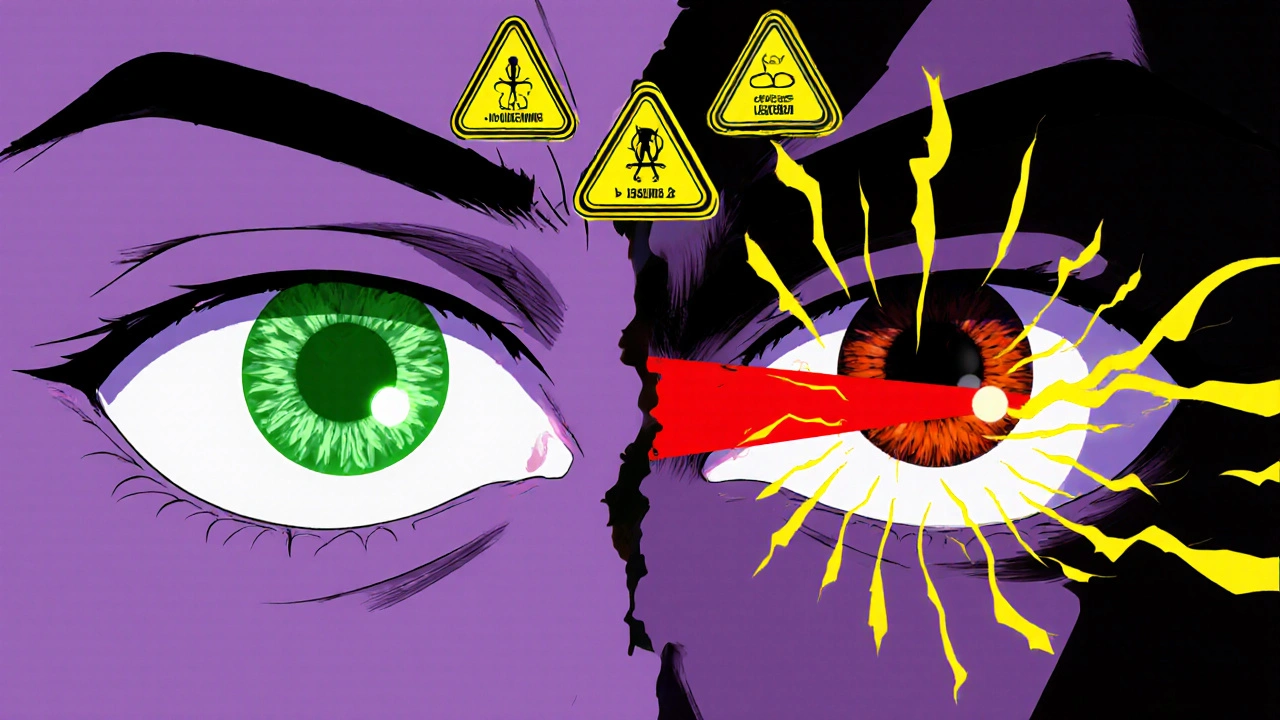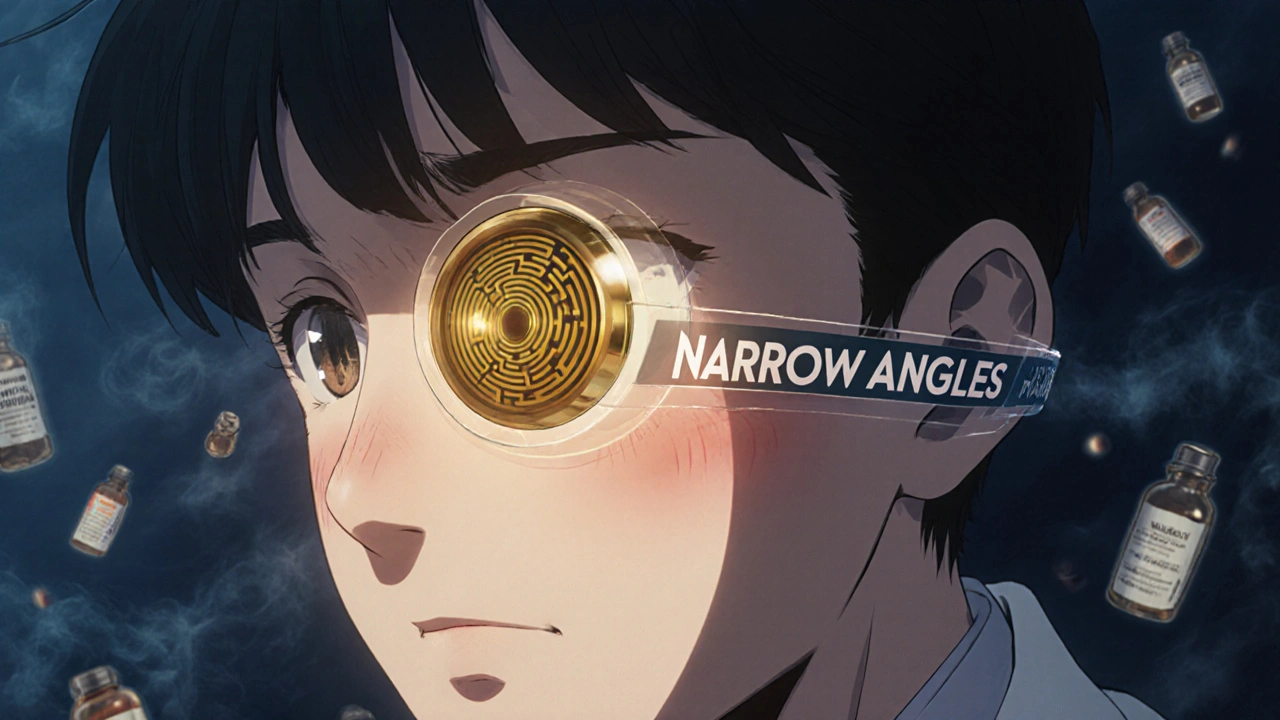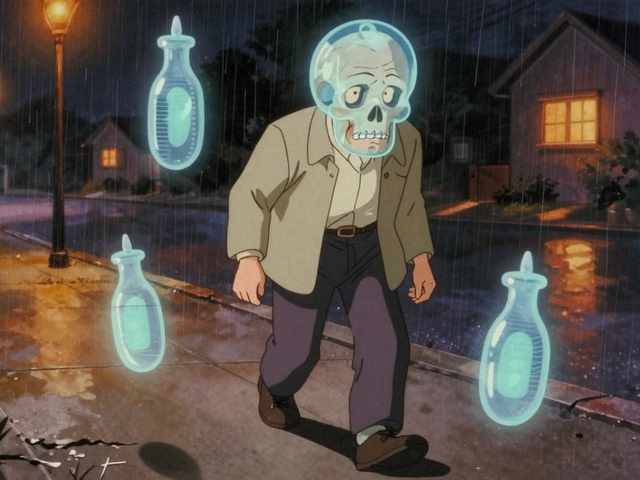Glaucoma Medication Risk Checker
Check Your Medication Safety
This tool helps you understand if your medications could increase glaucoma risk. Always consult your eye doctor for medical advice.
Your Risk Assessment
If you have glaucoma and reach for an over-the-counter allergy pill when pollen season hits, you could be putting your vision at risk - even if you feel fine. Many people don’t realize that common antihistamines like diphenhydramine (Benadryl) can trigger a sudden, sight-threatening eye emergency called acute angle-closure glaucoma. This isn’t a rare side effect. It’s a well-documented danger, especially for the 10% to 15% of glaucoma patients with narrow angles in their eyes - a condition many don’t even know they have.
What Happens When Antihistamines Hit the Eye
Antihistamines work by blocking histamine to stop sneezing, runny nose, and itchy eyes. But they don’t just target your nose. These drugs also affect nerves in your eyes, causing your pupils to dilate. In most people, that’s harmless. But if your eye’s drainage angle is naturally narrow - meaning the space between your iris and cornea is tight - that dilation can physically block the fluid outflow channel. Fluid builds up. Pressure spikes. In hours, you could lose vision.This isn’t theoretical. A study in the PMC7221246 database found that people taking daily anticholinergic drugs, including some antihistamines and antidepressants, had more than five times the risk of sudden angle-closure glaucoma. Older adults, women, and those with undiagnosed narrow angles are most vulnerable. And because this condition often has no symptoms until it’s too late, many people don’t know they’re at risk until they end up in the emergency room with blinding eye pain, nausea, and blurred vision.
Not All Glaucoma Is the Same
The biggest mistake people make is treating glaucoma like one condition. It’s not. There are two main types:- Primary open-angle glaucoma (POAG) - makes up 70% of cases. Fluid drains slowly over time. Most OTC allergy meds won’t harm you here - except steroids.
- Narrow-angle glaucoma - only 10-15% of cases, but far more dangerous with certain drugs. Even a single dose of diphenhydramine can trigger an attack.
If you have POAG, you can usually take second-generation antihistamines like loratadine (Claritin), cetirizine (Zyrtec), or fexofenadine (Allegra) safely. These don’t cross into the eye as easily and have minimal effect on pupil size. But if you have narrow angles - even if you’ve never had symptoms - these same drugs can be a ticking time bomb.
Other Hidden Risks in Your Medicine Cabinet
It’s not just antihistamines. Many everyday medications carry the same danger:- Decongestants - pseudoephedrine and phenylephrine (found in Sudafed, Claritin-D) can raise eye pressure by constricting blood vessels near the eye.
- Steroid nasal sprays, eye drops, or pills - even short-term use (over 10 days) can cause steroid-induced glaucoma. This form slowly raises pressure by clogging drainage tissue with protein buildup. It’s often silent until vision is damaged.
- Antidepressants - SSRIs like sertraline and escitalopram, and SNRIs like venlafaxine, have been linked to angle closure through lens-iris diaphragm movement.
- Anti-nausea drugs - Phenergan and Meclizine have strong anticholinergic effects that dilate pupils and block drainage.
- Migraine meds - Topamax and Sumatriptan can trigger acute angle closure in susceptible eyes.
- Sulfa-based drugs - like acetazolamide and sulfamethoxazole, can cause swelling in eye structures, pushing the iris forward and closing the angle.
Even Botox injections around the eyes - sometimes used for wrinkles or migraines - have been shown to raise eye pressure in people with narrow angles, according to 2023 clinical observations.

What You Should Do Right Now
If you have glaucoma, the first step isn’t to stop all allergy meds. It’s to find out what kind you have. Most people don’t know. That’s the problem.Ask your eye doctor: “Do I have open-angle or narrow-angle glaucoma?” If they don’t know, ask for a gonioscopy - a simple, painless test that looks directly at your eye’s drainage angle. The American Academy of Ophthalmology now recommends this for everyone over 40 during their first comprehensive eye exam.
If you have narrow angles:
- Avoid diphenhydramine, chlorpheniramine, and any OTC product labeled “PM,” “Nighttime,” or “for sleep.” These almost always contain anticholinergics.
- Choose second-generation antihistamines: Claritin, Zyrtec, Allegra. Still, check with your doctor first.
- Never use steroid nasal sprays or eye drops longer than 10 days without checking your eye pressure.
- Carry a medical alert card or bracelet stating you have narrow-angle glaucoma. Emergency staff need to know this if you’re in pain.
If you’ve had laser iridotomy - a procedure that creates a tiny hole in the iris to improve drainage - your risk drops significantly. But don’t assume you’re safe. Always confirm with your ophthalmologist before taking new meds.
What About Natural Alternatives?
Many people turn to “natural antihistamines” like quercetin, butterbur, or stinging nettle. But here’s the truth: there’s no solid evidence these are safer for glaucoma patients. They’re not regulated like pharmaceuticals. Their effects on eye pressure are unknown. And if you’re using them instead of proven treatments, you’re still risking exposure to allergens that worsen your symptoms.Saline nasal rinses, air purifiers, and avoiding triggers like pollen or smoke are safer, evidence-backed strategies. They don’t affect your eye pressure. And they work.

Why This Isn’t on the Label
You won’t find a warning about glaucoma on the back of a Benadryl bottle. The FDA doesn’t require it. Drugmakers aren’t obligated to list rare but serious eye risks unless they’re proven in large-scale trials. And because narrow-angle glaucoma is underdiagnosed, the link isn’t obvious to regulators.Glaucoma UK and other advocacy groups have been pushing for clearer labeling since 2022. Until then, the burden falls on you - and your eye doctor.
What’s Changing for the Better
There’s progress. Researchers are testing modified-release versions of loratadine that don’t penetrate the eye as deeply. A 2023 clinical trial (NCT04876321) is exploring whether this could make allergy relief safer for glaucoma patients. Meanwhile, studies show statins - used for cholesterol - may actually lower the risk of open-angle glaucoma progression. That’s promising, but it’s not a replacement for avoiding dangerous drugs.What’s most important now is awareness. With 3 million people in the UK alone living with glaucoma - and millions more undiagnosed - the number of people at risk from common meds is growing. As the population ages, so does glaucoma prevalence. The WHO projects a 30% global increase by 2030.
You can’t control that. But you can control whether you take a pill that could blind you.
Final Advice: Know Your Eyes
Don’t guess. Don’t assume. If you have glaucoma - or think you might - get a full eye exam. Ask for gonioscopy. Know your type. Keep a list of all your medications - including OTC and supplements - and bring it to every appointment.There’s no shame in asking your doctor: “Is this safe for my eyes?” That’s the only way to protect your vision. Because once the pressure spikes and the nerve damage starts, it’s permanent.
Can I take Zyrtec if I have glaucoma?
Yes, cetirizine (Zyrtec) is generally safe for people with glaucoma because it’s a second-generation antihistamine with minimal effect on pupil size. But if you have narrow-angle glaucoma, always confirm with your eye doctor first. Avoid Zyrtec-D or any version with pseudoephedrine - that decongestant can raise eye pressure.
Is Benadryl dangerous for glaucoma patients?
Yes, diphenhydramine (Benadryl) is one of the most dangerous OTC medications for people with narrow-angle glaucoma. It causes pupil dilation that can block fluid drainage, leading to sudden, severe eye pressure spikes. Even one dose can trigger an acute attack. Avoid it completely if you have any type of angle-closure glaucoma.
Can steroid nasal sprays cause glaucoma?
Yes. Steroid nasal sprays, eye drops, or pills can cause steroid-induced glaucoma, even if you don’t have glaucoma before. This happens when proteins build up and block the eye’s drainage system. It’s usually slow and painless - so you won’t notice until vision is damaged. Limit use to under 10 days and get your eye pressure checked afterward.
What’s the difference between open-angle and narrow-angle glaucoma?
Open-angle glaucoma means the drainage angle is open but fluid drains too slowly, raising pressure gradually. Narrow-angle glaucoma means the iris blocks the drainage angle, often suddenly. Open-angle is common and usually managed with drops. Narrow-angle is rarer but can cause sudden, blinding pressure spikes - especially when triggered by certain medications.
How do I know if I have narrow-angle glaucoma?
You won’t know unless you’ve had a gonioscopy - a test where your eye doctor uses a special lens to view the drainage angle. Most people with narrow angles have no symptoms until an attack happens. The American Academy of Ophthalmology recommends this test for everyone over 40 during their first comprehensive eye exam.
Can laser surgery fix narrow-angle glaucoma?
Yes. A laser peripheral iridotomy creates a tiny hole in the iris to allow fluid to flow freely and prevent angle closure. After this procedure, many people can safely take medications that were previously risky. But you still need to consult your eye doctor before using any new drugs - the procedure reduces risk but doesn’t eliminate it entirely.







Jeff Hakojarvi
18 November, 2025 23:55 PMI had no idea Benadryl could do this. My grandma takes it every night for sleep and she’s got glaucoma. I’m gonna call her doc tomorrow. Thanks for laying this out so clearly - I’ve seen people just pop these pills like candy. This is scary stuff.
Also, if you’re over 40 and haven’t had a gonioscopy, just do it. It’s five minutes. No drops, no pain. Your eyes will thank you.
Timothy Uchechukwu
20 November, 2025 13:36 PMSo now we’re blaming Big Pharma again? Maybe people should just stop being weak and deal with allergies naturally. Back in Nigeria we just used ginger and lemon and never needed pills. This whole western medicine obsession is ridiculous. Your body can handle it if you stop being lazy.
Also why is this even on Reddit? Shouldn’t you be at the clinic not scrolling?
Ancel Fortuin
21 November, 2025 05:35 AMOh great. So now the FDA is hiding eye-blasting dangers in plain sight? Classic. You think they care about your vision? Nah. They care about profit. The same people who let OxyContin slide are now letting Benadryl slide. And don’t get me started on how they ignored the link between SSRIs and angle closure for decades.
They’ll never warn you until someone dies. Then they’ll slap a tiny label on it and call it a day. Meanwhile, your doctor’s too busy to care. You’re on your own. Wear a medical bracelet. Carry a laminated card. Or just go blind quietly. Either way, the system wins.
Also - Botox? Really? Next they’ll say your yoga instructor is secretly giving you glaucoma.
And yes, I’ve had the laser. Still paranoid. And I’m right to be.
Hannah Blower
21 November, 2025 13:54 PMIt’s fascinating how society externalizes responsibility for health. You don’t read labels. You don’t ask questions. You don’t even know what gonioscopy means. And yet you expect the government to protect you from a drug that’s been known to cause angle closure since the 1970s.
It’s not about Benadryl. It’s about the collapse of medical literacy. We’ve turned healthcare into a consumer transaction. You want relief? Here’s a pill. You want safety? Good luck.
And the real tragedy? People with narrow angles are often asymptomatic. They’re walking time bombs. And they don’t even know it. That’s not a medical issue - it’s a philosophical one. Are we willing to be ignorant? Yes. And now we pay for it with our sight.
Also - Zyrtec is fine. But if you’re taking it because you’re too lazy to wash your pillowcase? That’s your problem, not the drug’s.
Gregory Gonzalez
21 November, 2025 17:11 PMLet me just say - if you’re taking anything with ‘PM’ in the name, you’re not just allergic to pollen. You’re allergic to responsibility.
And calling Zyrtec ‘safe’ is like calling a chainsaw ‘safe’ if you wear gloves. The fact that second-gen antihistamines are *less* risky doesn’t mean they’re risk-free. But of course, the author knows that. They just don’t want to scare you.
Also - ‘natural antihistamines’? Butterbur? That’s a liver toxin wrapped in a yoga mat. You’re not being holistic. You’re being stupid.
Ronald Stenger
22 November, 2025 16:06 PMLook - I’m a veteran. I’ve seen things. I’ve been in ERs. I’ve had my eyes checked after a concussion. And let me tell you - this is real. I had a buddy who took Benadryl for a cold. One hour later he couldn’t see. They had to do emergency laser surgery. He lost 30% of his vision. And he didn’t even know he had narrow angles.
People think glaucoma is just ‘old people losing sight.’ Nah. It’s a silent killer. And OTC meds are the silent enablers.
Also - if you’re using steroid sprays for more than 10 days? You’re playing Russian roulette with your optic nerve. Stop it.
Samkelo Bodwana
24 November, 2025 02:02 AMThere’s something deeply human about how we ignore the small risks until they become disasters. We take Benadryl because we’re tired. We use nasal sprays because we can’t breathe. We pop pills because life is hard. And we don’t want to think about our eyes until they’re screaming.
But here’s the thing - awareness doesn’t have to be scary. It can be empowering. Knowing your eye type isn’t about fear. It’s about freedom. Freedom to choose what you put in your body. Freedom to live without dread.
I’ve got open-angle glaucoma. I take Zyrtec. I use saline rinses. I check my pressure every six months. It’s not hard. It’s just different. And if you’re reading this, you’re already one step ahead of most people. So keep going. Don’t let the noise drown out the simple truth: your eyes matter. And you’re worth protecting.
Also - if you’re over 40 and haven’t had a gonioscopy, just ask. No shame. No drama. Just a quick glance from your doc. You’ll feel better. I promise.
Emily Entwistle
24 November, 2025 05:27 AMOMG I just checked my medicine cabinet and I’ve got like 4 different Benadryl bottles 😱 I thought it was just for allergies but now I’m like… wait I have glaucoma? 😳 I’m calling my eye doctor RIGHT NOW 💪🙏
Also Zyrtec is my fave so I’m so relieved!! But no more Zyrtec-D!! I thought the decongestant was just for congestion 😅
PS: Gonioscopy? Sounds like a spell from Harry Potter but I’m doing it. No more guessing. 🧙♀️👁️
Duncan Prowel
25 November, 2025 15:51 PMWhile the clinical data presented is largely accurate and well-sourced, one must consider the broader epidemiological context. The prevalence of undiagnosed narrow-angle glaucoma remains underreported in population-based studies, particularly in primary care settings where ophthalmological screening is not routine. The risk multiplier of 5x for anticholinergics, while statistically significant, must be contextualized against baseline incidence rates, which remain low in the general population.
Furthermore, the distinction between pharmacological action and anatomical predisposition is critical. The mechanism of pupil dilation is well-established; however, the threshold for angle closure varies significantly among individuals. A standardized risk stratification protocol - incorporating axial length, anterior chamber depth, and lens thickness - would be more informative than blanket avoidance of all antihistamines.
Finally, the assertion that natural alternatives are ‘unsafe’ due to lack of regulation is logically incomplete. The absence of evidence is not evidence of absence. Further longitudinal studies are warranted before dismissing botanical agents outright.
Bruce Bain
27 November, 2025 09:48 AMMan, I didn’t know all this. I just thought Benadryl made you sleepy. Now I get it - it’s not just your nose. It’s your eyes too.
My uncle had glaucoma. He never took those pills. He just stayed inside when pollen was high. Used a fan. Washed his face. That’s it.
Maybe we don’t need pills for everything. Just clean air and clean hands.
And if you’re not sure? Ask your doc. Simple. No magic. Just talk.
Jonathan Gabriel
28 November, 2025 08:27 AMSo let me get this straight - we’re being told to avoid antihistamines because they dilate pupils, which can trigger angle closure… but we’re not being told that most people with narrow angles have been screened since childhood in countries with universal eye care?
Here’s the real issue: this isn’t a drug problem. It’s a healthcare access problem. In the U.S., you need to know to ask for gonioscopy. In Sweden, they do it at 40 automatically. The drug isn’t dangerous. The system is.
And yet, we blame Benadryl. We blame the FDA. We blame Big Pharma. But the real villain? The fact that your eye doctor might not even know what gonioscopy is - and you have to Google it yourself.
Also - yes, I typo’d ‘gonioscopy’ three times while writing this. I’m not a doctor. But I know enough to know I need to see one.
And yes, I’m getting tested tomorrow.
Don Angel
29 November, 2025 03:21 AMI’m so glad someone finally said this. I’ve been telling my mom for years not to take Benadryl, and she just rolls her eyes. Now I’m printing this out and handing it to her. With highlights. And a sticky note that says ‘DO NOT IGNORE.’
Also - I just checked my Zyrtec bottle. No decongestant. Good. But I’m still writing down every single thing I take. Medications. Supplements. Even that herbal tea I drink. I’m keeping a little notebook now. Just in case.
Thank you. Seriously. This could save someone’s sight. And that’s huge.
benedict nwokedi
29 November, 2025 07:16 AMOf course they didn’t put a warning on Benadryl. The same people who sold you cigarettes with ‘light’ labels are selling you sleep aids with ‘gentle’ on the bottle. They don’t want you to know that your eye pressure can spike in 90 minutes. They want you to keep buying. They want you to keep trusting. They want you to be silent.
And don’t believe the ‘Zyrtec is safe’ nonsense. It’s just a slower poison. The real danger? The fact that your doctor doesn’t test for narrow angles unless you beg. That’s not medicine. That’s negligence wrapped in a white coat.
And Botox? Yeah. That’s not just for wrinkles. That’s a pressure bomb. You think they’d tell you? Nah. They’re too busy selling you the next treatment.
Wake up. The system is rigged. And your eyes are the collateral.
deepak kumar
30 November, 2025 17:16 PMI live in India, and here many people use neem oil or tulsi leaves for allergies - but no one talks about eye safety. This post is eye-opening. I have a cousin with glaucoma - I will tell him right away to avoid all PM medicines.
Also, in India, people use steroid creams for rashes - and never think about eyes. This is dangerous. We need more awareness here too.
My uncle took Zyrtec for years. No problem. But he had his eyes checked every year. That’s the key - regular checkups. Not just avoiding pills. Knowing your body.
And yes, I spelled ‘glaucoma’ right this time. 😅
Dave Pritchard
30 November, 2025 18:03 PMHey - if you’re reading this and you’re scared? That’s okay. But don’t panic. Just act.
Step one: Call your eye doctor. Ask: ‘Do I have open-angle or narrow-angle glaucoma?’
Step two: If they don’t know - ask for gonioscopy. Say it out loud. It’s a real word.
Step three: Make a list of everything you take. Even the ‘natural’ stuff.
Step four: Bring that list to every appointment.
You don’t have to be perfect. You just have to be aware.
I’ve been helping people with glaucoma for 15 years. The ones who survive? They didn’t know everything. They just asked one question: ‘Is this safe for my eyes?’
You’re not alone. And you’re not weak for asking.
Now go make that call. I believe in you.
Jeff Hakojarvi
1 December, 2025 07:18 AMJust talked to my mom. She’s got narrow angles. She’s been taking Zyrtec-D for years. She’s switching to plain Zyrtec tomorrow. Also got her to schedule gonioscopy. Thanks again.
Also - I just found out my cousin had laser surgery last year. Said it felt like a tiny laser dot. No pain. Now she can take antihistamines safely. Life-changing.